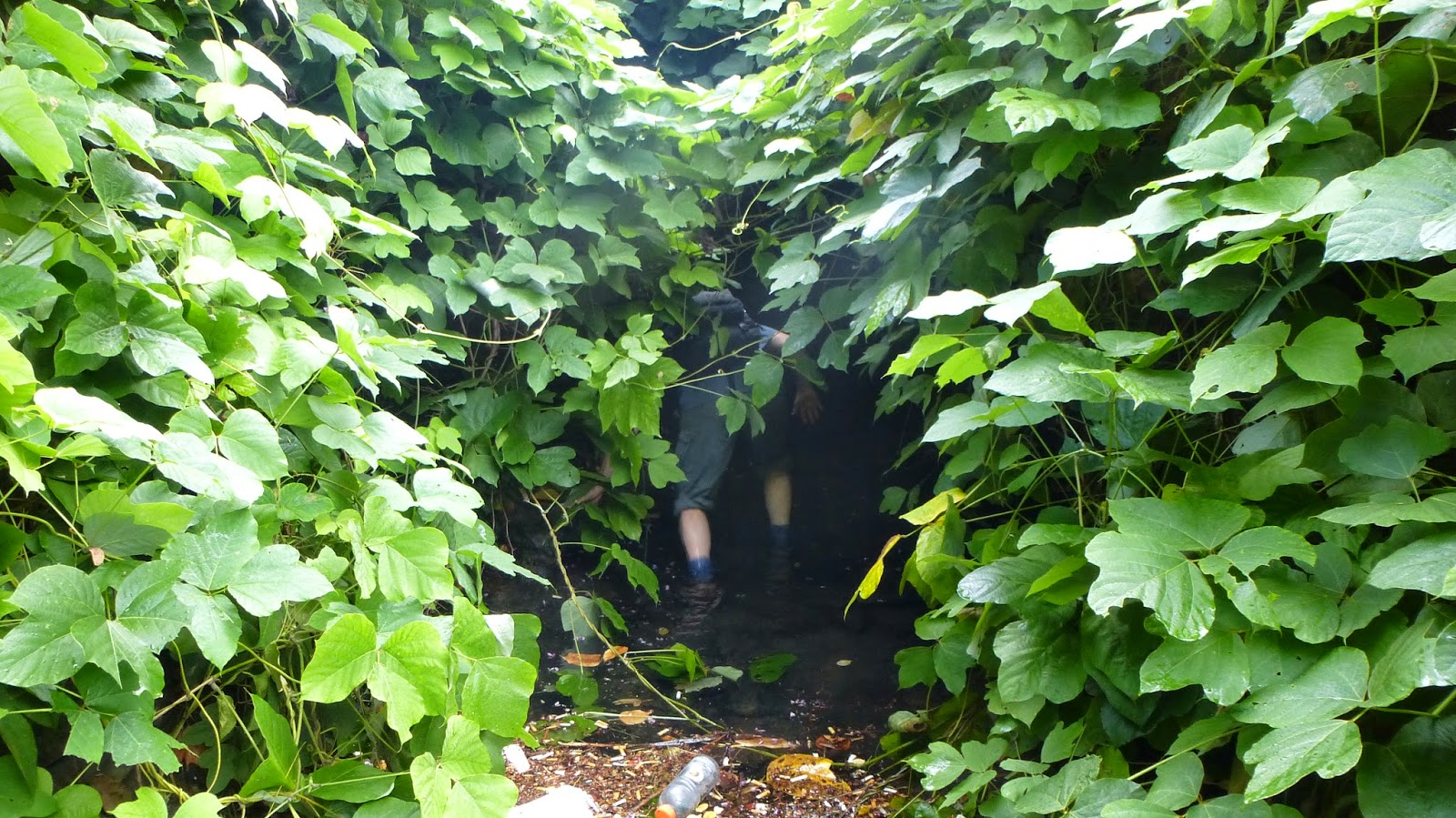Will disappears into the kudzu
I should probably state right now, these are not the "prohibition tunnels" under Asheville. We are in a storm sewer under Asheville. So, why are we there? I spent the weekend with buddy, Will, at his Montreat home. Arriving very late Friday night, I learn Will has spoken with someone that evening at supper about first hand experience in the tunnels below Asheville. Earlier in the day, a group of 6 walked into these tunnels and spent a hour to an hour and a half. Upon hearing this, we just had to do this. We knew there were tunnels below downtown which had a prohibition connection. The tunnel entrance in Pack's Tavern is well documented and was part of a UNC TV documentary on the prohibition era in North Carolina. I've since learned, there are other entrances, some from credible sources and some are mere internet rumors. However, these tunnels have been collapsed in a number of places due to development and of course any entrances into buildings would have been blocked.
On Saturday, we found ourselves drinking a beer at One World Brewing. I asked Will how long did he think the girls would be at the nearby Chocolate Lounge. He replied, "long enough for us to go check out that tunnel entrance". So we gulped down the beer and headed to the spot we were told (vaguely, I might add) where the tunnel could be accessed. We were turned back by a plainclothes police officer at one point but waited until he was out of sight to continue. After walking around a bit, we thought we knew the general area but weren't dressed to get down in the creek and look closely.
Sunday, while visiting a couple "dive bars" in West Asheville, we run into 2 members of the tunnel group. Upon further quizzing, we learn we were in the right spot the day before. However, after processing some of the responses, I figure these are just part of the storm sewer system. Nevertheless, we can't let this adventure not be fulfilled. Early Monday morning, we are headed to Asheville. The unposted parking area next to a favorite drinking spot for homeless folks and a small creek is our destination. We wait until there is no one present and head down into the creek hidden by kudzu.
Tunnel entrance
We are able to rock hop without getting wet, but we know we will be in water soon. Most folks who might want to do this will likely be rebuffed at this point. The creek enters a tunnel under the road. The sides are mostly stone but the roof is wooden timbers holding up some corrugated sheets of metal. It doesn't look like it will last forever. Right before and then into the tunnel, the water depth is between knee and thigh deep. This may be a deterrent to most. Once about 30 feet into the tunnel, the water depth becomes more manageable but still uneven and slick. After crossing under the road, the tunnel becomes mostly concrete and the water depth is only ankle deep. We are able to walk standing up. There is a collapsed cavity to the left side. I smell some bad air at this point but only for a few feet. We both have headlamps and Will carries a bigger flashlight. It is still dark and hard to see where you are stepping. We make a lot of splashing noise. When we come to a junction, there is concrete tunnel going right and metal culvert pipe going left. We take the right tunnel but after a very short distance, the tunnel becomes low and appears to be collapsed ahead. So we turn back and head into the metal culvert. This is easy walking as the water is just ankle deep and the height is about 5'8".

Too low to continue ahead
I'm guessing we are in the metal pipe for 100 to 150 yards when we come to stone sided tunnel, seen below. This becomes narrow and then low. We see a pipe crossing the tunnel and we'll have to crawl to get by it. At this point we have been in the tunnel 20 minutes and may have traveled 2/3 mile. We're satisfied at this point and turn around.
Under downtown Asheville
I think the collapsed tunnel back at the junction was the original route of the sewer but when I-240 was build, it was abandoned and the newer metal culvert was used. Once we reached the other end of the metal culvert, we were back in original sewer. At this point, we think we were under Broadway and Woodfin. There were some manhole covers above in spots. We were afraid to push any up to see where we were since it would have been active roadways. At one point we could hear traffic, but mostly we just heard the echos of our splashing.
It was a fun adventure but I'm not ready to do it again.

























